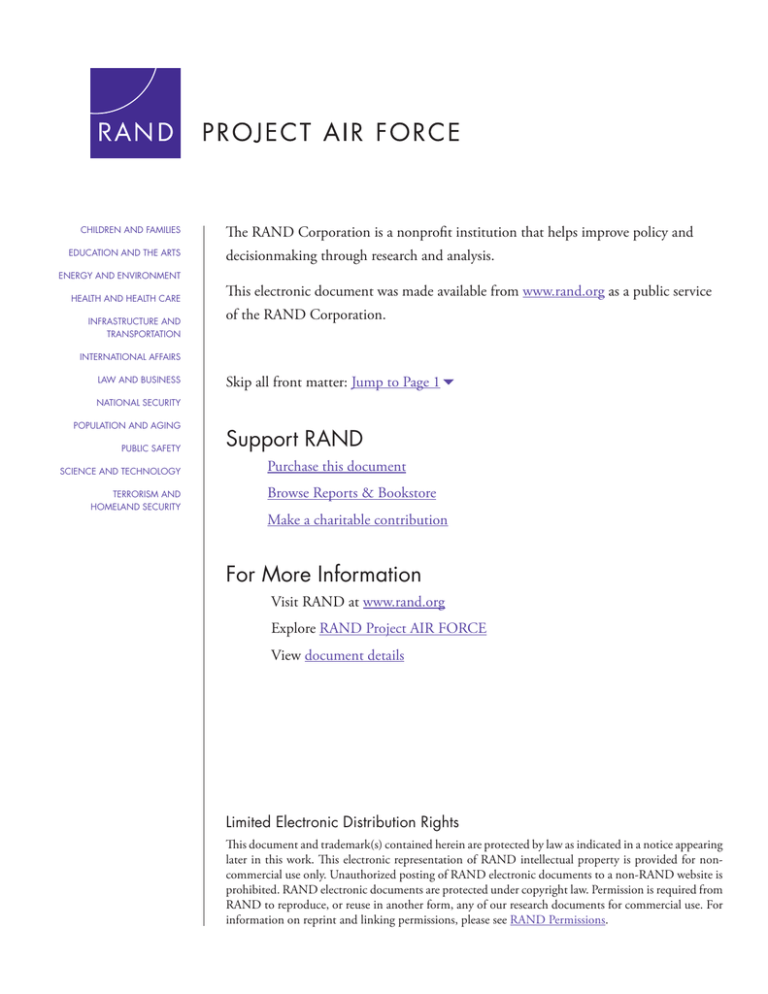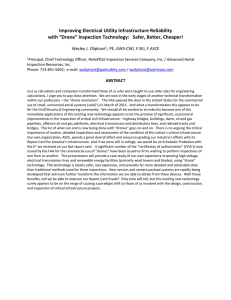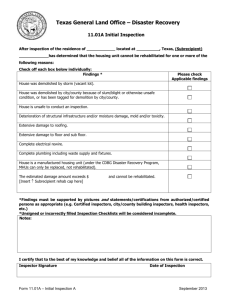The RAND Corporation is a nonprofit institution that helps improve... decisionmaking through research and analysis.
advertisement

CHILDREN AND FAMILIES EDUCATION AND THE ARTS The RAND Corporation is a nonprofit institution that helps improve policy and decisionmaking through research and analysis. ENERGY AND ENVIRONMENT HEALTH AND HEALTH CARE INFRASTRUCTURE AND TRANSPORTATION This electronic document was made available from www.rand.org as a public service of the RAND Corporation. INTERNATIONAL AFFAIRS LAW AND BUSINESS Skip all front matter: Jump to Page 16 NATIONAL SECURITY POPULATION AND AGING PUBLIC SAFETY SCIENCE AND TECHNOLOGY TERRORISM AND HOMELAND SECURITY Support RAND Purchase this document Browse Reports & Bookstore Make a charitable contribution For More Information Visit RAND at www.rand.org Explore RAND Project AIR FORCE View document details Limited Electronic Distribution Rights This document and trademark(s) contained herein are protected by law as indicated in a notice appearing later in this work. This electronic representation of RAND intellectual property is provided for noncommercial use only. Unauthorized posting of RAND electronic documents to a non-RAND website is prohibited. RAND electronic documents are protected under copyright law. Permission is required from RAND to reproduce, or reuse in another form, any of our research documents for commercial use. For information on reprint and linking permissions, please see RAND Permissions. This product is part of the RAND Corporation technical report series. Reports may include research findings on a specific topic that is limited in scope; present discussions of the methodology employed in research; provide literature reviews, survey instruments, modeling exercises, guidelines for practitioners and research professionals, and supporting documentation; or deliver preliminary findings. All RAND reports undergo rigorous peer review to ensure that they meet high standards for research quality and objectivity. technic a l REP O RT Charting the Course for a New Air Force Inspection System Frank Camm • Laura Werber • Julie Kim • Elizabeth Wilke • Rena Rudavsky Prepared for the United States Air Force Approved for public release; distribution unlimited PROJECT AIR FORCE The research described in this report was sponsored by the United States Air Force under Contract FA7014-06-C-0001. Further information may be obtained from the Strategic Planning Division, Directorate of Plans, Hq USAF. Library of Congress Cataloging-in-Publication Data is available for this publication. ISBN: 978-0-8330-7704-2 The R AND Corporation is a nonprofit institution that helps improve policy and decisionmaking through research and analysis. RAND’s publications do not necessarily reflect the opinions of its research clients and sponsors. R® is a registered trademark. © Copyright 2013 RAND Corporation Permission is given to duplicate this document for personal use only, as long as it is unaltered and complete. Copies may not be duplicated for commercial purposes. Unauthorized posting of RAND documents to a non-RAND website is prohibited. RAND documents are protected under copyright law. For information on reprint and linking permissions, please visit the RAND permissions page (http://www.rand.org/publications/ permissions.html). Published 2013 by the RAND Corporation 1776 Main Street, P.O. Box 2138, Santa Monica, CA 90407-2138 1200 South Hayes Street, Arlington, VA 22202-5050 4570 Fifth Avenue, Suite 600, Pittsburgh, PA 15213-2665 RAND URL: http://www.rand.org To order RAND documents or to obtain additional information, contact Distribution Services: Telephone: (310) 451-7002; Fax: (310) 451-6915; Email: order@rand.org Summary Air Force senior leadership relies on inspections, assessments, and evaluations to advise it on the efficiency, effectiveness, readiness, and level of compliance of Air Force activities. Conducted by several different organizations within the Air Force, these oversight tasks have grown dramatically over time, despite repeated efforts to limit the burden they place on individual Air Force units. Although Office of the Inspector General of the Air Force (SAF/IG) inspections constitute only about one-fourth of this burden, SAF/IG has the responsibility to set inspection policy and oversee the inspection and evaluation systems for the Air Force as a whole. In 2010, SAF/IG began an aggressive effort to improve inspection policy by reducing the burden it places on inspected units and increasing the quality of relevant information it generates for the Secretary and Chief of Staff of the Air Force and for commanders throughout the Air Force. At SAF/IG’s request, in late 2010, RAND Project AIR FORCE (PAF) joined this effort. The RAND Corporation conducted analyses related to five major inspection system goals that SAF/IG and its Inspection System Improvement Tiger Team (ISITT) were pursuing: 1. 2. 3. 4. 5. choosing a better inspection interval reducing the inspection footprint increasing the emphasis on self-inspections and self-reporting introducing the new Unit Effectiveness Inspection (UEI) introducing the Management Internal Control Toolset (MICT). We relied on multiple data sources to inform our analysis: a review of practices the Air Force Inspection System might emulate, such as the Air Force Culture Assessment Tool program (AFCAST), the Air Force Climate Survey, and the Federal Aviation Administration (FAA) inspection system; an investigation of Air Force personnel’s experiences in the field, which included the observation of a compliance inspection, focus groups with inspectors, and interviews and focus groups with members of recently inspected wings; and a review of literature on leadership, organizational change, and other topics. Choosing a Better Inspection Interval Under the existing inspection system, the interval between inspections varies significantly across the Air Force. The Air Force leadership is moving toward standardizing and shortening this interval so that one major inspection occurs at every non-nuclear, active component wing every two years. This will ensure that wing commanders, who usually serve in a wing for two xiii xiv Charting the Course for a New Air Force Inspection System years, will face a major inspection during each tour. When we asked Air Force inspectors and inspectees about this proposed change, more favored this approach than any other. In contrast, the FAA uses a very different approach to inspect the commercial aviation system. It carefully varies the inspection interval across activities to reflect (1) the inherent risk associated with specific aviation-related activities; (2) attributes unique to individual inspected organizations, like the history of their past performance or the stability of their operating environment or leadership team; and (3) the resources available to conduct inspections in any year. We suspect this tailored approach allows the FAA to use its constrained inspection resources to reduce more risk than would the proposed Air Force approach, given the same resources. Some Air Force personnel suggested that an inspection frequency consistent with the FAA’s approach may be feasible for the Air Force as well. Reducing the Inspection Footprint The Air Force is seeking ways to reduce (1) the number of days each year that a wing is subject to some external oversight event, and (2) the resources consumed—by both inspectors and inspectees—for each event. To this end, the Air Force has already begun synchronizing IG inspections and functional assessments so that they occur on the same days. It also plans to integrate such events so that fewer external inspectors and assessors are required and wing personnel spend less time preparing for and talking with those who come. The Air Force inspectors and inspectees we spoke to generally support such an approach, but also noted that achieving effective integration will be challenging. The FAA relies heavily on both formal sampling and no-notice inspections in its own inspection system. The Air Force could use formal sampling strategies, which require less information than is typically collected under the existing system, to assess wing performance. The Air Force could also make greater use of no-notice inspections—inspections that occur with very little advance notice—to keep wings on their toes at all times and reduce the resources required to complete individual inspections. The Air Force inspectors and inspectees we talked to do not have strong views on sampling, but generally favored much greater use of no-notice inspections. Increasing the Emphasis on Self-Inspections and Self-Reporting Our investigation of Air Force personnel’s experience in the field revealed concerns about relying more heavily on the wings’ self-inspection programs, at least in their current incarnation. Inspectors noted that both the quality and the nature of self-inspection programs varied greatly under the existing inspection system. Also, personnel from recently inspected wings felt that some units lack people with the skills required to detect and resolve weaknesses without external support. Both inspectors and inspectees worried that personnel within a wing find it hard to be honest with themselves about the weaknesses of that wing and resist reporting such weaknesses outside the wing. However, the FAA’s successful voluntary reporting programs can serve as models the Air Force might consider to encourage honest self-reporting by wing personnel. In addition, personnel themselves proposed a number of ways to place greater emphasis on self-inspection and Summary xv self-reporting work, such as having wing personnel provide an “external look” at other parts of the wing. The FAA’s experience and the ideas shared by Air Force personnel themselves hint that SAF/IG’s plan to develop a more robust commander’s inspection program (CCIP) is feasible. Moreover, actions some wings already take to prepare for compliance inspections, such as internal Tiger Teams and compliance exercises, suggest that requiring wings to use a variety of formal self-inspection mechanisms may not be a drastic departure from current practice. Introducing the New Unit Effectiveness Inspection (UEI) SAF/IG’s vision for a new inspection system includes a new type of inspection, the UEI, which will subsume elements of the compliance inspection in place at the time of our research. One planned component of the UEI is an assessment of a wing’s discipline and leadership. Our fieldwork and review of scholarly research did not yield definitive guidance on how to measure discipline. In contrast, however, measuring leadership within the new UEI holds promise. Overall, our results indicate that, in spite of some inspectors’ reluctance to assess leadership during a compliance-focused inspection (based on their experience with the existing system), there are both the reason and the means to do so. Specifically, we found compelling evidence of a link between leadership and performance, and identified several well-validated, practicable ways to measure leadership. Air Force personnel cited a number of leadership characteristics they deemed important that have already been operationalized in the Air Force Manpower Agency’s Climate Survey and AFCAST survey, for instance. Methods developed by academics, such as the Multifactor Leadership Questionnaire (MLQ), psychological safety measures, and the use of data aggregation, suggest additional and often complementary ways of assessing not only the effectiveness of a wing commander, but also that of the entire wing leadership chain of command. Introducing the Management Internal Control Toolset (MICT) In 2009, the Air Force began to introduce a new standard information management tool to all of its reserve component wings. MICT allows a wing to record and manage information on items from an inspection checklist or any other item the wing commander deems important to the wing’s performance. When this information reveals a shortfall, MICT facilitates the management of a corrective action program that tracks progress until the root cause of the shortfall is brought under control. Based on overall positive experience to date, the Air Force is now introducing MICT to all active component wings. The Air Force inspectors and inspectees we spoke to generally like the idea of a system like MICT, but are quite skeptical that MICT will yield the benefits it has promised. Their past experience with new information systems has led them to worry that MICT will be too hard to use, will not work as well as the local systems they use now, will not come with enough resources to sustain appropriate training and user support, and might even invite resource managers to cut resources for inspectors based on the belief that fewer inspectors will be needed after MICT is introduced. There is no objective evidence from Air Force experience to date to support these concerns, but the Air Force will need to address them to ensure the success of its MICT implementation. xvi Charting the Course for a New Air Force Inspection System Implementing Significant Organizational Change The changes the Air Force leadership is pursuing raise basic cultural issues that must be addressed before these changes achieve their maximum benefits. A formal approach to change management has emerged and evolved over the last three decades that is well suited to facilitating this kind of change in a large, complex organization like the Air Force. This new approach to formal change management (1) plans for a change, (2) then executes it, and (3) finally, sustains the change until it becomes part of routine operations. The planning process addresses the tightly interrelated tasks of designing change, creating highlevel support, and convincing individual organizational members that they will benefit more from the change than from opposing it. It breaks a change into manageable chunks, like blocks of new aircraft, each of which can be built relatively quickly. The execution stage uses training, monitoring, adjustment, and extensive communication to learn from the ongoing implementation of each incremental chunk, correct weaknesses quickly as they are exposed, and provide senior leaders with constant empirical evidence that the change is yielding its expected benefits. Sustainment migrates each incremental change to the dominant command and control system of the organization as a whole. The FAA has used elements of this approach to effectively achieve changes similar to those the Air Force is now seeking to implement. The Air Force can particularly learn from how the FAA has pursued major change in its own inspection system since the 1970s. In this report, we offer many possible ways of doing this, as summarized below. Recommendations Through our own analysis and discussions with Air Force personnel in SAF/IG and the ISITT, we formulated the following recommendations, which are presented in detail in Chapter Eight of this report. General Risk Management Consider adopting a formal risk management system to guide Air Force inspection-related decisions and activities. SAF/IG should take the lead in developing a risk management system suited to the new inspection system. Without such a system in place, several of the recommendations below (marked with asterisks) may not be feasible. The Inspection Interval Initially condition the frequency of inspection of specific activities on risk management factors.* Over the longer term, revisit the decision to move to one major inspection every two years for each wing.* The Inspection Footprint As future external inspections become more focused and reduce in size, ensure that they continue to capture the priorities of the IG and the relevant functional area communities.* Apply formal sampling guidance to reduce the burden of inspections and increase their productivity.* Use information on a wing’s past performance to design the focus and depth of each full inspection. Summary xvii Self-Inspection and Self-Reporting Foster conditions for psychological safety to increase the willingness of all individuals in wings to report weaknesses. Consider adapting some aspects of FAA’s voluntary reporting system as part of the new CCIP. This system would maintain the anonymity of individuals reporting from within wings to encourage more honest reporting. Support wings’ efforts to preserve the “external look,” a mechanism many wings use today to have personnel assess each other across squadrons or other wings. Measures of Leadership Ensure that measures of leadership take into consideration the full chain of command, not just the wing commander. Recognize that leadership and discipline are multi-faceted constructs and measure them as such. Consider the use of qualitative methods to measure leadership, but ensure that they are standardized across inspection teams and sites. Develop a new UEI survey that adopts items from existing survey instruments. Use other existing data sources to inform the inspection process. MICT Follow through to ensure that MICT is implemented cost-effectively. Institute and sustain an approach to using MICT that maintains (1) standard core information and (2) wing-unique information. Recognize MICT as a complement to external inspections and assessments and internal self-inspection, not a replacement for them. Maintain the accuracy of any information in MICT that is freely available to external overseers at the major command (MAJCOM) or Air Force level. Full, Air Force–Wide Implementation As the inspection system changes, keep in mind that it has many moving parts and operates as part of a broader governance system. Anticipate and disarm negative perceptions about proposed changes. Expect that full implementation will take time and plan for this by breaking change into incremental chunks and managing each end-to-end. Use formal pilot tests to help monitor and refine increments of change before they are implemented throughout the Air Force. Additional Analysis to Support Implementation Develop more detailed quantitative analysis of the costs of the inspection system. Translate the risk assessment framework recommended here into guidance for an Air Force risk assessment system. Develop concrete and specific guidance that translates formal sampling methods into practical instructions inspectors can apply to increase the quality of information they can collect with given resources. Develop the basis for a more precise and operational definition of discipline. Tailor the broad implementation guidance offered in Chapter Seven to an Air Force setting.




